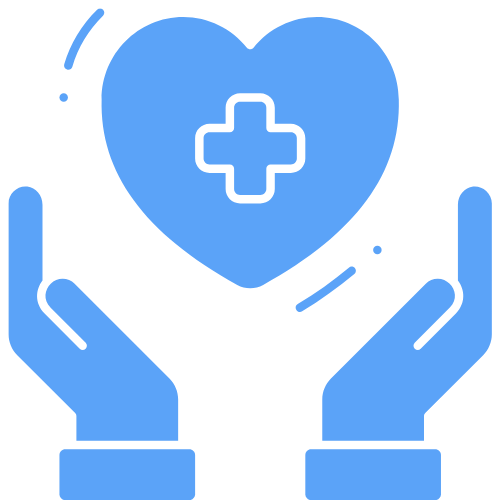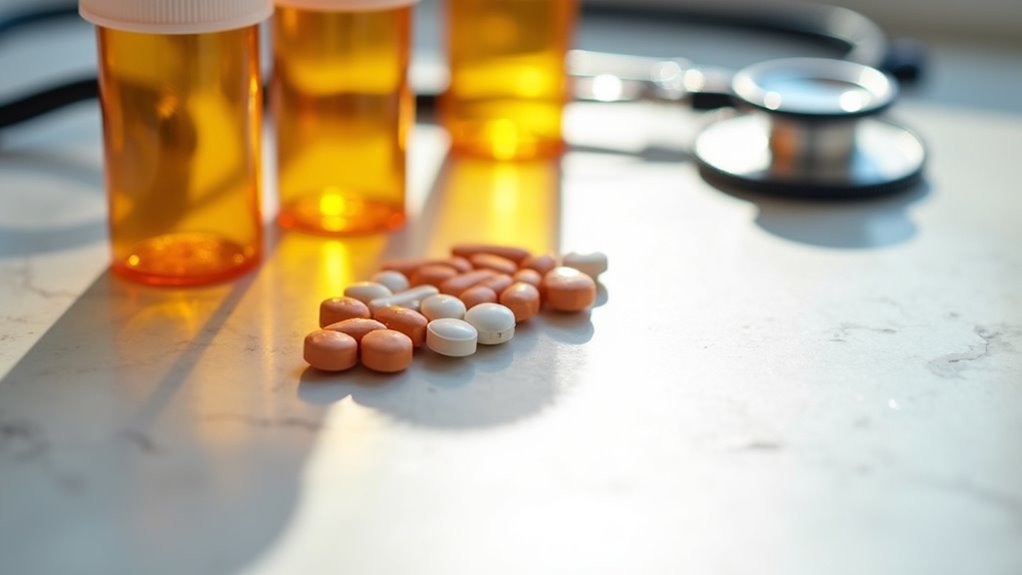To prevent Suboxone misuse, you’ll need to implement multiple evidence-based strategies. Start by establishing clear healthcare team protocols and strong prescription monitoring systems. Train your staff to recognize warning signs and educate patients about proper medication use. Secure storage practices, patient counseling, and regular follow-up appointments are essential. You’ll also want to utilize prescription drug monitoring programs and maintain detailed documentation. These core interventions form just the foundation of a thorough prevention strategy.
Establishing Strong Healthcare Team Communication

While preventing Suboxone misuse requires a multi-faceted approach, establishing strong healthcare team communication serves as the foundation for successful treatment outcomes. Implement structured protocols and documentation systems that integrate notes from all providers to support coordinated decision making. Regular team huddles facilitate alignment of treatment plans and enable swift responses to emerging challenges. FDA-approved medications remain effective treatment options that should be discussed openly among healthcare teams. Research shows that utilizing practice facilitators with clinical experience in OUD care delivery helps provide crucial implementation support for clinics.
Establish clear feedback loops between clinicians and administrators to address systemic barriers and optimize streamlined referral processes. The integration of stigma-reducing language when discussing patient cases helps foster a more supportive treatment environment. Set up supportive communication channels that foster interdisciplinary collaboration, particularly when monitoring patient adherence to treatment regimens. Deploy integrated documentation systems that allow prescribers, nurses, and counselors to share real-time updates and concerns. This robust communication framework guarantees consistent oversight and improves treatment efficacy.
Implementing Robust Prescription Monitoring Systems
Because prescription monitoring plays an essential role in preventing Suboxone misuse, implementing sturdy tracking systems must be your top priority. Use data analytics to track prescription patterns across providers, focusing on quantities, refill frequencies, and potential doctor shopping behaviors.
Establish real-time information sharing between prescribers and pharmacists to verify prescription legitimacy and prevent unsafe drug combinations. Monitor for red flags such as overlapping prescriptions, rapid refills, or multiple provider visits. You’ll need to implement specific thresholds that trigger alerts when patients receive concurrent opioid prescriptions or show suspicious dispensing patterns.
Link your monitoring system to CDC guidelines while analyzing geographic and demographic trends. This thorough approach has proven effective, as demonstrated by Kentucky’s 8.5% reduction in controlled substance dispensing after implementing PDMP mandates.
Training Staff to Recognize Early Warning Signs

As healthcare organizations combat Suboxone misuse, training staff to recognize early warning signs becomes critical for prevention and intervention. You’ll need to implement thorough monitoring staff training programs that focus on identifying key behavioral indicators, including doctor shopping, frequent dose escalation, and early refill requests. Teaching staff about the vital role of ongoing counseling support helps ensure comprehensive patient care and better treatment outcomes.
Evaluating staff training effectiveness requires guaranteeing your team can spot physical symptoms like unusual drowsiness and withdrawal signs, while recognizing psychological red flags such as preoccupation with obtaining medications. Staff should understand that opioid replacement abuse commonly occurs in cycles of withdrawal management. Providing education about how patients often combine Suboxone with central nervous system depressants can help staff identify dangerous drug interactions. Train your staff to document prescription patterns and assess risk factors systematically, particularly when patients have substance abuse histories or mental health comorbidities.
Encourage interdisciplinary communication and make certain your team understands how to properly utilize shared electronic databases for tracking prescription histories and patient behaviors.
Educating Patients and Families on Safe Use
Proper education of patients and families forms the cornerstone of preventing Suboxone misuse through essential practices like secure medication storage and early warning sign recognition. Utilizing a combination of medications and counseling provides the most effective treatment approach for substance use disorders. You’ll need to establish strict protocols for keeping Suboxone in locked containers away from children while learning to identify concerning behaviors such as taking extra doses or mixing with other substances.
Family members can provide pivotal support by monitoring medication adherence, attending educational sessions, and maintaining open communication about treatment progress.
Safe Storage At Home
Successful storage of Suboxone at home requires careful attention to both environmental conditions and security measures. Keep your medication in a secure cabinet storage system between 59°F-86°F, away from moisture-rich areas like bathrooms and kitchens. Maintain optimized medication organization by storing strips separately from other prescriptions to prevent mix-ups. Locked medication boxes are required when transporting take-home doses from the clinic. Taking proper precautions is essential since Suboxone contains partial opioid agonists that require careful monitoring to prevent misuse.
You’ll need to protect strips from direct sunlight and freezing temperatures to preserve their efficacy. Use child-resistant containers and place them in locked, inaccessible locations out of children’s and pets’ reach. When managing your supply, implement an initial-expired, first-out approach and regularly check expiration dates. Don’t store strips in high-traffic areas, and always maintain the original packaging for proper identification. Regularly inspect your stored strips for any signs of changes in texture that could indicate compromised medication. Dispose of unused medication through authorized take-back programs to prevent potential misuse.
Recognizing Warning Signs
Identifying early warning signs of Suboxone misuse requires vigilant monitoring of three key areas: physical symptoms, behavioral changes, and psychological indicators.
Watch for physical symptoms like dilated pupils, excessive sweating, and unexplained weight loss. When identifying symptom patterns, pay attention to behavioral red flags such as seeking multiple prescriptions or possessing drug paraphernalia. You’ll also need to monitor for psychological changes including unusual euphoria, emotional detachment, or sudden mood swings. Patients may also exhibit poor memory coordination as cognitive functions become impaired.
Environmental triggers can worsen misuse risks, so observe if there’s unsupervised Suboxone use, combining with other substances, or drug-seeking behaviors beyond prescribed doses. Effects can last up to 72 hours after administration, making it crucial to maintain consistent monitoring. If you notice multiple warning signs, especially social withdrawal or cognitive impairment, consult a healthcare provider immediately. Early intervention can prevent severe withdrawal symptoms and long-term health consequences.
Family Support During Treatment
Family support plays a central role in preventing Suboxone misuse and maintaining treatment adherence. You’ll achieve better outcomes through ongoing family counseling and recovery coach involvement, which create a structured environment for accountability. Research shows family-based interventions reduce substance use frequency by 5.7%. Comprehensive programs that focus on maternal emotion regulation have demonstrated significant success in supporting long-term recovery outcomes. Patients can receive treatment from licensed practitioners who have completed specialized training in medication-assisted treatment. Studies indicate that combined buprenorphine/naloxone medications are most effective due to their lower potential for abuse.
| Support Type | Key Benefits | Implementation |
|---|---|---|
| Family Therapy | Bolstered Communication | Weekly Sessions |
| Recovery Coaching | Treatment Adherence | Regular Check-ins |
| Education Sessions | Safe Use Knowledge | Monthly Workshops |
| Support Groups | Shared Experiences | Bi-weekly Meetings |
| Crisis Planning | Risk Prevention | Quarterly Updates |
When families actively participate in treatment protocols, monitor medication use, and maintain regular communication with healthcare providers, patients show improved compliance and reduced risk of relapse. Your family’s engagement in structured therapy approaches strengthens recovery success through consistent support and accountability.
Creating Comprehensive Storage and Tracking Protocols
Establishing sturdy storage and tracking protocols forms the cornerstone of Suboxone misuse prevention in clinical settings. You’ll need to implement a multi-layered security approach that includes tamper-evident packaging and multi-factor access controls requiring two authorized staff members for medication retrieval.
Your facility must maintain pharmaceutical-grade refrigeration units with documented temperature logs while adhering to DEA’s 21 CFR Part 1301 regulations. Install real-time electronic tracking systems integrated with your EMR, featuring barcode scanning from storage to administration. Implement automated alerts to flag unusual prescribing patterns and potential diversion risks.
Regular audits comparing medication orders with inventory levels are essential. Use secure disposal bins with non-retrievable designs and maintain thorough electronic medication logs with dual-signature verification to ensure complete accountability throughout the medication lifecycle.
Integrating Behavioral Support With Medical Treatment
Beyond secure medication protocols, successful Suboxone treatment demands a synchronized approach combining medical interventions with evidence-based behavioral support. Treatment plan customization should integrate cognitive-behavioral therapy, motivational interviewing, and structured contingency management to reinforce medication adherence.
You’ll need to participate in regular group therapy sessions and relapse prevention counseling while maintaining connections with peer support networks. These behavioral components help you develop essential coping mechanisms and social skills. Your provider will coordinate biweekly toxicology screenings alongside therapy to monitor progress and adjust interventions as required.
Family therapy sessions can address co-occurring relationship challenges, while mandatory 12-step program participation provides additional accountability. The stepped-care model allows providers to adjust treatment intensity based on individual patient responses. This extensive integration of behavioral support with medical treatment substantially improves your chances of sustained recovery from opioid use disorder.
Developing Community-Based Support Networks
Strong community-based support networks serve as essential pillars for preventing Suboxone misuse and sustaining long-term recovery. Through strategic partnerships with grassroots organizations and healthcare providers, you’ll find extensive support systems that address both medical and social aspects of recovery. Peer mentor programs connect you with experienced individuals who understand the challenges of maintaining treatment adherence.
Key components of effective community networks include:
- Cross-sector coalitions that use real-time data tracking to identify service gaps and adjust intervention strategies
- Family-based support systems combined with culturally sensitive outreach to reach marginalized populations
- Accessible community hubs offering immediate MAT referrals, naloxone training, and harm reduction education
These evidence-based approaches create a substantial support framework that improves treatment outcomes while reducing medication diversion risks.
Setting Up Emergency Response Plans
Effective emergency response plans for Suboxone misuse require systematic protocols across healthcare settings and precise coordination among providers. You’ll need to establish clear documentation systems for tracking doses, monitoring patient adherence, and flagging potential diversion risks through digital health records.
When coordinating interdisciplinary care, guarantee your ED staff conducts frequent reassessments within 1-2 hours of each dose administration. Set up real-time communication channels between emergency departments, pharmacists, and addiction specialists to verify prescriptions through state PDMP data. Foster community partnerships by creating direct referral pathways to local treatment centers and support services.
Implement a 72-hour response protocol that includes immediate withdrawal assessment using COWS, stepwise buprenorphine dosing up to 16mg daily, and mandatory follow-up scheduling before discharge.
Building Effective Patient Follow-Up Systems
Implementing detailed follow-up systems requires a multi-layered approach that combines weekly medical evaluations, structured adherence monitoring, and integrated support services. Substantially patient monitoring systems should incorporate both urine testing and pill counts to verify medication compliance, while customized adherence support programs connect patients with counseling and peer networks.
Schedule regular medical evaluations to track progress, adjust dosing, and identify potential misuse risks early.
Implement structured monitoring protocols including urine screening, pill counts, and documented follow-up appointments.
Utilize telehealth and routine contact methods to maintain consistent engagement, especially during early recovery phases.
You’ll achieve better outcomes by integrating behavioral skill-building through relapse prevention counseling and maintaining extended treatment phases of 12+ weeks, which show considerably higher success rates compared to shorter programs.
Standardizing Care Across Treatment Settings
Establish standardized care pathways that incorporate evidence-based protocols for Suboxone® prescribing, monitoring, and dose adjustments across all treatment settings.
You’ll need to implement consistent documentation systems and communication channels to guarantee seamless coordination between physicians, nurses, counselors, and pharmacists involved in patient care.
Your standardization efforts should include uniform screening procedures, dosing protocols, and follow-up schedules that align with regulatory requirements while accommodating site-specific resources and patient populations.
Clear Care Pathway Development
A thorough care pathway for Suboxone treatment requires standardization across all clinical settings to optimize patient outcomes and prevent misuse. You’ll need to implement individualized care planning that aligns with the OUD Cascade of Care model while conducting holistic needs assessments to identify potential risk factors for diversion.
Establish structured protocols for patient evaluation using validated screening tools to assess medical contraindications, mental health status, and social determinants that could impact treatment adherence.
Develop clear documentation standards for tracking patient progress through key treatment stages from engagement through remission using measurable metrics like prescription refills and clinic visits.
Create explicit guidelines for adjusting treatment plans based on patient response, incorporating both pharmacological management and psychosocial support services to address underlying barriers to recovery.
Seamless Treatment Team Communication
While coordinating care across multiple providers presents inherent challenges, standardizing treatment team communication serves as the cornerstone of effective Suboxone therapy management. You’ll need to implement structured multidisciplinary care coordination through regular team meetings, clear role definitions, and shared care protocols.
Establish real-time information sharing via integrated EHR systems and secure communication portals to track patient progress and medication histories.
Train your staff in standardized documentation practices and cross-disciplinary terminology. Utilize technology-driven solutions like PDMP integration and telehealth platforms to facilitate seamless consultations between primary care providers and addiction specialists.
Implement mandatory check protocols and audit processes to guarantee guideline adherence. Regular case conferences and structured feedback loops help maintain consistent care delivery while addressing complex patient needs promptly.
Frequently Asked Questions
Can Suboxone Be Safely Used During Pregnancy or While Breastfeeding?
While you can use Suboxone during pregnancy and breastfeeding, it’s crucial to work closely with your healthcare provider to monitor risks of Suboxone exposure.
Research shows it’s generally safer than other opioids, with lower rates of neonatal abstinence syndrome and minimal effects on infant development. However, you’ll need careful medical supervision throughout pregnancy and breastfeeding.
Don’t stop taking Suboxone without medical guidance, as sudden discontinuation can be dangerous.
How Long Does Suboxone Stay in Your System After Stopping Treatment?
Suboxone’s presence in your system varies depending on the testing method. In urine, it’s detectable for 7-14 days, while blood tests show it for up to 2 days.
The drug’s main component, buprenorphine, has a half-life of about 37 hours in your body, leading to complete elimination in roughly 8 days. Your withdrawal timeline may extend beyond the drug’s presence, depending on your dosage, metabolism, and length of treatment.
What Happens if I Miss a Dose of Suboxone?
If you miss a single dose of Suboxone, you likely won’t experience significant withdrawal symptoms due to the medication’s long-acting properties.
If it’s several hours before your next scheduled dose, you can take the missed dose. However, if it’s close to your next dose, skip the missed one and resume your regular schedule.
Don’t try to make up missed doses by doubling up, as this can be dangerous. Contact your healthcare provider for dosage adjustments if you miss multiple doses.
Can I Travel Internationally With My Prescribed Suboxone Medication?
Yes, you can travel internationally with prescribed Suboxone, but you’ll need to follow specific requirements. Always carry your medication in your carry-on luggage with the original prescription label.
You must bring a doctor’s letter explaining your treatment and check customs regulations for each country you’ll visit, including layovers. Some nations require advance declaration or may restrict buprenorphine, so research destination-specific rules before departure.
Does Insurance Typically Cover Suboxone Treatment and Related Counseling Services?
Most insurance plans cover Suboxone treatment, but coverage details vary greatly. You’ll likely face prior authorization requirements, especially for extended-release formulations.
While Medicaid typically offers extensive coverage, private insurers may have provider network limitations that restrict where you can receive treatment. Counseling services are often covered separately, and you’ll need to verify specific coverage details with your insurer.
Be prepared for potential cost-sharing requirements and coverage limits for both medication and therapy services.















